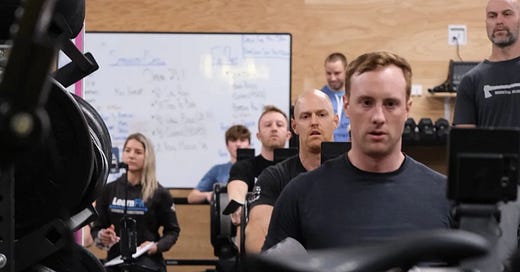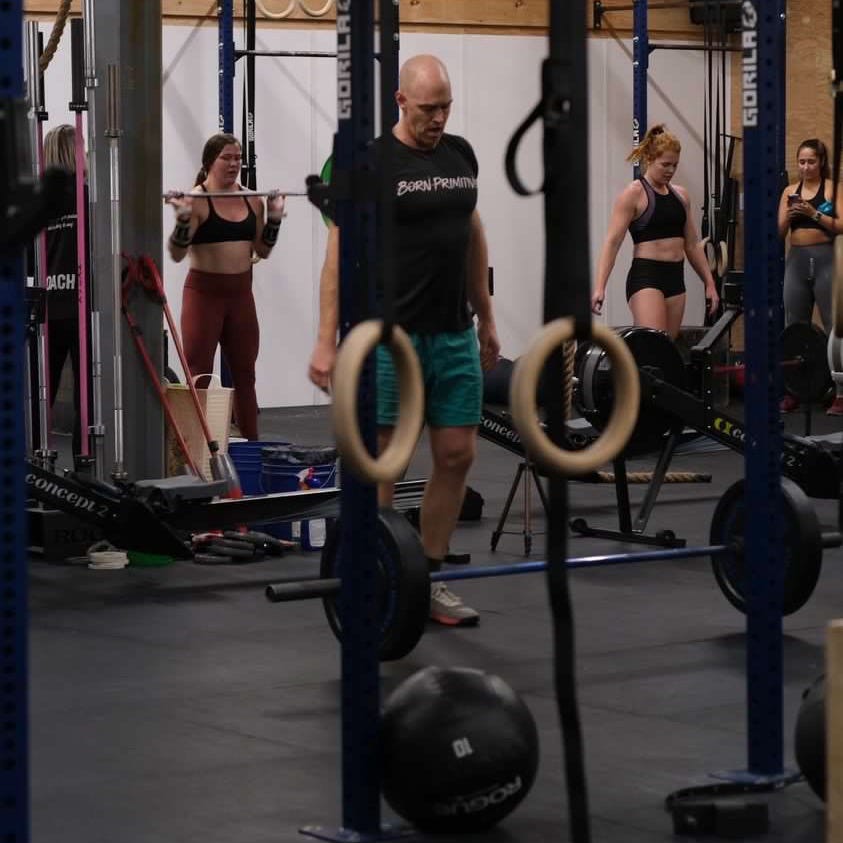On Supercharged Socializing
The kind of high-quality leisure activities we all need more of in our lives.
Serious expressions, but having fun! Photo: Janice Verceles Cody
We are in the final week of the CrossFit Open. This is a worldwide competition that kicks off an annual search for the fittest on Earth by ranking performances on three specific workouts. Those who do well move on to the next level of competition, until eventually the top performers go to the CrossFit Games, held each summer.
Every Friday night during the Open's three consecutive weeks, members of my local gym gather to do these workouts together. While none of us is contending for that top spot, it does not dampen our enthusiasm for giving it a shot. We show up with friends and family in tow (many of whom cannot understand our commitment to this sport), bearing snacks and drinks to share after the workout.
I've been part of a CrossFit community for over 10 years. I joined a gym way back in 2012 and, while my membership has changed locations, I've gone consistently, anywhere from two to five times per week. When people comment on my dedication, I attribute it partly to the fact that I work from home and need a place to go to see and talk to other adults. Sure, CrossFit and its functional movement exercises do wonders for one's body, but really what makes it unique is the social aspect.
I've long understood the social appeal subconsciously, but it wasn't until I read Digital Minimalism: Choosing a Focused Life in a Noisy World by Cal Newport that I grasped it on a more intellectual level. Newport writes about the concept of "supercharged socializing," defined as "interactions with higher intensity levels than are common in polite society." He says this is a common property of high-quality leisure activities, which are precisely the kinds of activities that humans need to cultivate if they hope to pull themselves away from excessive reliance on digital devices and reconnect with others in a genuine way.
Supercharged socializing refers to interactions with higher intensity levels than are common in polite society.
Newport writes, "The secret to CrossFit's success is probably best captured by one of the most notable differences between a CrossFit box and a standard gym: no one is wearing headphones." Indeed, an event like the Open would be impossible with headphones on. Instead, we are all united by a common goal of completing the same workout, at the same time, listening to the same song on the speaker. We're watching, engaged, and talking about every aspect of it. We're in it together—and it brings us together.
CrossFit is just one example Newport gives of supercharged socializing. Others include various kinds of social fitness and recreational sports leagues, physical board games, most volunteer activities, or working with a team on group projects, like building a neighborhood skating rink. I'd add religious practices to that list, too, like going to church.
Newport identifies two traits in the most successful social leisure activities. These are (1) spending time with other people in person, and (2) participating in an activity that provides some sort of structure for social interaction, including rules to follow, insider terminology, and a shared goal. With these conditions met, perhaps it's not so surprising that people bond over something as odd as doing push-ups, jumping rope, and picking up a barbell. Newport writes:
"Your CrossFit buddies will holler and whoop, and give you emphatic high fives and sweaty hugs with a joyous enthusiasm that would seem insane in most other contexts."
Photo: Janice Verceles Cody
He's absolutely right. We finished the last Open workout and the people contained within physical space felt so close, so full of goodwill and satisfaction and pride and belonging. You can't help but love people who are willing to suffer beside you and cheer you on. We lingered long after the workout ended, polishing off the potluck contributions and talking in that elevated, animated way that results when you've just been through something hard but good together. It was a million times better than an evening spent scrolling through social media.
I'm not telling everyone to start doing CrossFit (I'm past that stage in life, ha). But I do think there's value in finding your tribe, finding a place where you too can enjoy supercharged socializing and let loose a bit. The value added to my life by that community goes far beyond the fitness—and that was not something I expected to find when I joined so many years ago.






I love the concept of supercharged socializing. CrossFit sounds great. In my world, partner dance serves this role. Many social dances fulfill the two traits here, and my own personal passion, Argentine Tango (the original, improvised version) definitely makes it easy to spend hours without looking at a phone! Thank you for this.
This is so on point and well written. Great article, Kat!